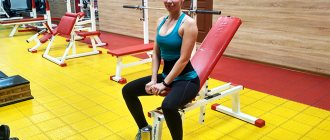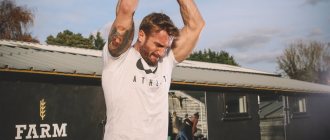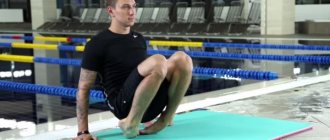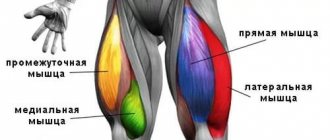Training programsWeight programs
Primary goal:
muscle mass gain
Type:
split
Fitness level:
average
Number of workouts per week:
4
Necessary equipment:
barbell, dumbbells, EZ-bar (curved bar), exercise equipment
Audience:
men and women
Series "Strength, Muscle and Fire"
- Three-day split “Strength, Muscle and Fire”
- Four-day split “Strength, Muscle and Fire”
- Five-day split “Strength, Muscle and Fire”
- Strength, Muscle and Fire: diet and sports nutrition for weight gain
Author:
Steve Shaw
The training program is aimed at achieving extreme results and maximum muscle mass gain by working each muscle group using differentiated sets based on the principle of Strength, Muscle and Fire.
Description of the training program
Back in 1986, my mentor, Dr. Mike, told me about a training system using graduated repetitions per set. In those days, I was young and trusting, and therefore I did everything that my teacher said. After all, Dr. Mike was a successful natural bodybuilder who also had a degree and was a professor. In short, it was simply impossible not to trust him, and after just three years of using his training system, I achieved fantastic results. Over the next ten years, I have been faithful to Dr. Mike's training philosophy, and it has never let me down. This approach to strength training helped me get big and strong. What more could you ask for?
The training program we bring to your attention is based on the system of Dr. Mike. Of course, over time I had to adjust it a little, but I hope that my experience will be useful to you. If you become a real apologist for the method and stick to it for 10 years or more... well, then you will have every right to make adjustments. Remember, no system can be considered ideal until it is adapted to your individual characteristics and needs.
Dr. Mike was ahead of his time. He approached the training process from a scientific point of view in those days when everyone around him just repeated the mantra “The Weider Principles imply this...” or “The Weider Principles imply this...”. Meanwhile, the main principle of bodybuilding is extremely simple - muscles react differently to sets with different numbers of repetitions. Dr. Mike believed that by incorporating all reasonable repetition variations into a training program, we would achieve maximum muscle hypertrophy and consistent strength gains. This principle worked for me, and I hope it will work for you too. And to learn more about the effect of the number of repetitions per set on muscle hypertrophy, read the material “Muscle Hypertrophy and Mass Gain.”
Components of the Strength, Muscle and Fire program
My Strength, Muscle and Fire training system will help you build muscle mass and increase strength through a special approach to the training process: we will have three set options, all of which we will use in one workout. For each target muscle group we will perform the following types of sets:
- Force.
Strength sets begin the training session. Strength sets involve performing 3 to 5 repetitions, using the same weight for all sets. If you're doing 5 reps on each set, increase the weight. We do 2 to 4 strength sets for the main muscle groups, and two strength sets for small muscles within one workout. It should be noted that for certain muscle groups, performing strength approaches is impractical, and sometimes even unrealistic. For example, it’s hard to even imagine what a strength set for the abdominal muscles should look like.
- Muscles.
A muscle set consists of 6-12 repetitions with the same working weight. As you begin to hit the 12-rep threshold, increase the weight. We do a total of 4-6 muscle sets for the main muscle groups within one workout, but we use two exercises. Small muscles receive 2 to 4 muscle sets per workout with 1 or 2 exercises. In addition, you can do 3 sets of one exercise.
- Fire.
For each target group we perform 1-2 fire sets, using mainly isolation exercises. We choose a weight that allows us to do 15 to 20 repetitions, and then increase the number of repetitions to 40. How? We do as many repetitions as we can, rest a little and return to the exercise. The pause should be extremely short so that we replenish energy reserves for only 1-3 repetitions. Overcoming the burning pain, we perform the exercise until the total number of repetitions reaches 40. And if in the first approach we do more than 25 repetitions, we increase the working weight. We perform two fire sets for the main muscle groups, and one or two fire sets are enough to work out small muscle groups.
Psycho-emotional arousal
Well, I think everything is clear here. Let's take a person and ask him to push the maximum weight that he can. And then we’ll take the same person, put a gun to his head and say that if he doesn’t now bench press 10 kg more than he just bench pressed, we’ll shoot him. And, lo and behold! Strength increases! ))
Everything is quite simple here. Muscles contract with a force directly proportional to the strength of the signal from the brain that reaches them via motor neurons. The stronger the signal, the stronger the contraction. And the more excited you are, the stronger the signal the brain is able to send. This is why athletes (especially lifters) beat themselves and scream before going on the platform. Personally, I did the same at the beginning of my sports career. But then I realized that aerobatics is when you go onto the platform absolutely calm and at the same time show the maximum result. This probably comes with age.
Notes and comments
- Failure
- I do not advise you to work to the point of complete failure. Try to perform each set until you feel like you can’t do another repetition, and at that point stop the exercise. If at some point you accidentally reach this point of failure, it’s okay, but you don’t need to purposefully paint yourself into a corner with every approach. - Moving towards the goal
- Your main task is to progress during each workout and each approach. Sets performed carelessly are a waste of time and effort. If you are not feeling well or have little time, do not chase the number, but focus on fewer quality approaches. - Split options
- Of course, you have the right to adjust the training program to fit your schedule, but do not forget that it is not advisable for a natural bodybuilder to exercise more than 4 times a week. Which split is the best? One that you can stick with for a long period of time. - Minor Changes
- What if I don't want to stick to the 6-12 rep rule and want to do 6 to 10 reps?
Feel free to move on to 6-10 repetitions. What if I don't like the idea of 3-5 reps on a strength set? Then do 4 to 6 repetitions. Having a hard time doing 40 reps on a fire set? Go for 30 muscle-burning reps. Note:
Minor changes are okay as long as you stick to the fundamental principles of this training program. Don't focus on the little things - just think about how to lift more weight and get bigger! - Alternating exercises
- Alternating exercises every week is not a bad idea. It is clear that it is impossible to perform all the exercises for the target group in one training session. For example, as a muscle set for the pectoral muscles, you can use dumbbell flyes one week, and dips the next. - Total number of sets
- It's best to start with a minimum number of sets, and when you feel it's time to increase the load, add more sets to your training program. - Calf Muscles
- Please note that there are no strength sets for the calf muscles. I have no reason to believe that the calf muscles respond well to low reps. - Quadriceps
- If you like to endure pain, add an isolated set of 20 squats to your fire sets for the quads.
Sports nutrition for the Muscle Strength and Fire program
To get maximum results from the program, you naturally need to eat right and supplement your diet with sports supplements. To become big and muscular, you need to eat like a big person, and not like a ten-year-old girl. Be prepared to consume a huge amount of calories and do it wisely.
The key supplement when gaining weight is a high-quality gainer that can provide a body exhausted by training with fast carbohydrates to replenish energy costs and quickly digestible protein to achieve an anti-catabolic effect.
Before training, to strengthen mental functions and increase energy potential, it is recommended to take pre-workout complexes. The vitamin-mineral complex will provide growing muscles and the body with the necessary set of vitamins and microelements. Don’t forget that an athlete’s need for vitamins is an order of magnitude greater than the need of an office worker leading a sedentary lifestyle, and regular multivitamins from the pharmacy will not be enough for you.
Creatine, as one of the most recognized and effective supplements, should also be included in the minimum kit of an athlete seeking to quickly gain weight.
Recommended sports supplements for the Muscle Strength and Fire program
Dymatize Elite Mass Gainer
High quality gainer. Allows you to get the maximum amount of calories and protein without digestive discomfort.
BSN NO Xplode 2.0
A pre-workout supplement that increases strength and endurance and accelerates the growth of lean muscle mass.
Twinlab Dualtabs
Long-acting multivitamins in a two-layer tablet! Completely covers the daily requirement of vitamins and minerals during increased stress.
Optimum Nutrition Micronized Creatine Powder
Pure creatine monohydrate. Increases strength and accelerates muscle growth!
What else affects strength?
In addition to muscle size, the following parameters influence the level of strength:
- tendon thickness is a genetic indicator. Muscle strength will increase as long as the tendon can bear the load. Tendons can only be slightly strengthened by training;
- the ratio of red and white fibers is a genetic indicator. White (fast) fibers are responsible for explosive short-term strength, red (slow) for duration and endurance;
- muscle elasticity - the greater the difference between the stretching of a muscle and its contraction, the greater the force they can produce. With regular stretching, you can increase muscle elasticity;
- the site of tendon attachment is a genetic indicator. The farther the muscle is attached from the joint, the more weight it can lift;
- the number of muscle fibers is a genetic indicator that cannot be changed;
- psycho-emotional state - the stronger the emotional arousal, the “louder” the signal from the brain to the muscles. In an excited state, muscles contract more intensely, this increases strength;
- muscle innervation . The brain signal to the muscle fibers travels along the motor neurons (motor nerves), causing them to contract. The more motor neurons that come to a muscle, the more motor units that can be recruited. With regular training, motor neurons weave a dense network around the muscles.
Muscle strength also depends on gender (due to testosterone, men are stronger than women) and age (the fastest results can be achieved between 15-25 years). Genetic predisposition also has a major influence on the maximum possible level of strength.
Despite gender differences and innate physical abilities, everyone, having set a goal, is able to achieve significant results.











